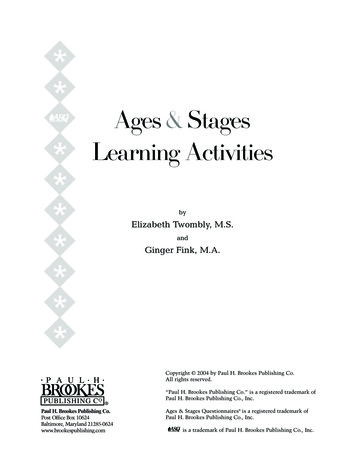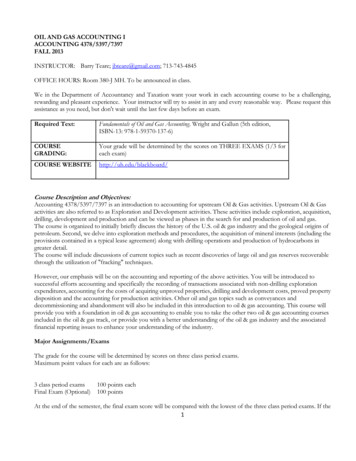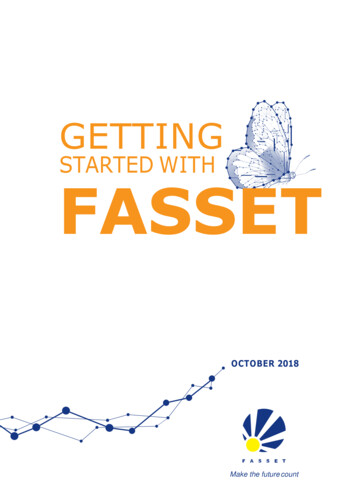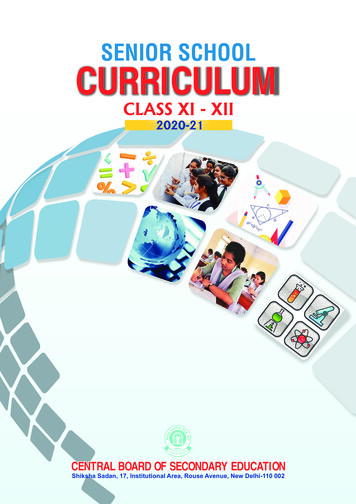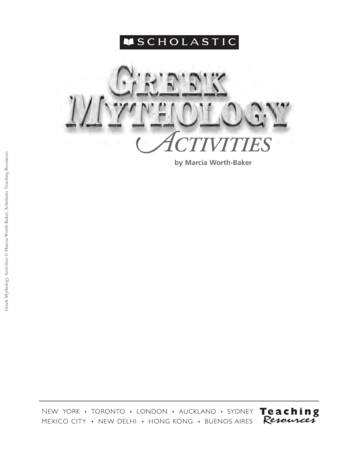
Transcription
Greek Mythology Activities Marcia Worth-Baker, Scholastic Teaching ResourcesACTIVITIESby Marcia Worth-BakerNEW YORK TORONTO LONDON AUCKLAND SYDNEYMEXICO CITY NEW DELHI HONG KONG BUENOS AIRES
DED I C A T I O NuAcknowledgmentsI am grateful to the North Caldwell faculty, notably Dr. Betty Ann Wyks and Jack Venezia,and to my many memorable AAP students. I benefited from Virginia Dooley andCarol Ghiglieri’s excellent editing. I also appreciate the encouragement of my parents,especially my mother, Catherine Dwan. I thank David for sharing his love of the ancients,Abby and James for their patience, and Charlie for his well-timed arrival.Scholastic Inc. grants teachers permission to photocopy the activity pages in this book for classroom use.No other part of this publication may be reproduced in whole or in part, or stored in a retrieval system, or transmitted in any formor by any means, electronic, mechanical, photocopying, recording, or otherwise, without written permission of the publisher.For information regarding permission, write to Scholastic Professional Books, 557 Broadway, New York, NY 10012.Cover design by Jason RobinsonCover illustration by Tim JessellInterior illustrations by Teresa Southwell except page 64 by Maxie ChamblissInterior design by Sydney WrightISBN: 0-439-51788-5Copyright 2005 by Marcia Worth-BakerPublished by Scholastic Inc.All rights reserved.Printed in the U.S.A.1 2 3 4 5 6 7 8 9 104011 10 09 08 07 06 05Greek Mythology Activities Marcia Worth-Baker, Scholastic Teaching ResourcesFor David
ContentsIntroduction . . . . . . . . . . . . . . . . . . . . . . . . . . . . . . . . . . . .4The Brass Birds . . . . . . . . . . . . . . . . . . . . . . . . . . . . .43Using This Book . . . . . . . . . . . . . . . . . . . . . . . . . . . . . . . . .4The Sacred Deer . . . . . . . . . . . . . . . . . . . . . . . . . . . .44Cleaning the Augean Stables . . . . . . . . . . . . . . . .44Greek Mythology Activities Marcia Worth-Baker, Scholastic Teaching ResourcesCHAPTER 1Getting Started With MythsVisit to the Amazons . . . . . . . . . . . . . . . . . . . . . . .45What Is a Myth? . . . . . . . . . . . . . . . . . . . . . . . . . . . . . . . . .6Diomedes’ Horses . . . . . . . . . . . . . . . . . . . . . . . . . .45Writing a Myth . . . . . . . . . . . . . . . . . . . . . . . . . . . . . . . . . .7A Fire-Breathing Bull . . . . . . . . . . . . . . . . . . . . . . . .46Myths in the Night Sky . . . . . . . . . . . . . . . . . . . . . . . . . . .7The Monster’s Cattle . . . . . . . . . . . . . . . . . . . . . . .46The Geography of Ancient Greece . . . . . . . . . . . . . . . . . .8Hera Gets Involved Again . . . . . . . . . . . . . . . . . . . . . . .47Maps of the Ancient World . . . . . . . . . . . . . . . . . . . . . . . .8Three Golden Apples . . . . . . . . . . . . . . . . . . . . . . .47Capturing Cerberus . . . . . . . . . . . . . . . . . . . . . . . .48CHAPTER 2Mighty Mount Olympus!What Happened Next to Heracles? . . . . . . . . . . . . . . .48The Beginning of the World . . . . . . . . . . . . . . . . . . . . . .14How Mortals Were Made . . . . . . . . . . . . . . . . . . . . . . . .14CHAPTER 4Who Started the Trojan War?Welcome to Mount Olympus! . . . . . . . . . . . . . . . . . . . .15A Read-Aloud Play: “The Apple of Discord” . . . . . . . .55Ask-a-God . . . . . . . . . . . . . . . . . . . . . . . . . . . . . . . . . . . . .16Whodunnit? . . . . . . . . . . . . . . . . . . . . . . . . . . . . . . . . . . .56It’s Fate . . . . . . . . . . . . . . . . . . . . . . . . . . . . . . . . . . . . . . . .16Wanted! . . . . . . . . . . . . . . . . . . . . . . . . . . . . . . . . . . . . . . .56Oracles and Omens . . . . . . . . . . . . . . . . . . . . . . . . . . . . .17Tales From Troy . . . . . . . . . . . . . . . . . . . . . . . . . . . . . . . .56Zeus Says: A Greek Game . . . . . . . . . . . . . . . . . . . . . . .18Homer’s Heroes . . . . . . . . . . . . . . . . . . . . . . . . . . . . . . . .57Count on Athena! . . . . . . . . . . . . . . . . . . . . . . . . . . . . . .19Make a Trojan Horse . . . . . . . . . . . . . . . . . . . . . . . . . . . .57On the Way to Ithaka . . . . . . . . . . . . . . . . . . . . . . . . . . .58CHAPTER 3Heroic HeraclesEveryday Greek . . . . . . . . . . . . . . . . . . . . . . . . . . . . . . . .58Make a Mini-Book . . . . . . . . . . . . . . . . . . . . . . . . . . . . . .38Inescapable Conflict! . . . . . . . . . . . . . . . . . . . . . . . . . . .38CHAPTER 5Making ConnectionsHeracles’ Conflicts . . . . . . . . . . . . . . . . . . . . . . . . . . . . .39Mythology in the Marketplace . . . . . . . . . . . . . . . . . . .72Rank the Labors . . . . . . . . . . . . . . . . . . . . . . . . . . . . . . . .39Let’s Have a Pantheon! . . . . . . . . . . . . . . . . . . . . . . . . . .73Make It Modern! . . . . . . . . . . . . . . . . . . . . . . . . . . . . . . .39Write an Encomium . . . . . . . . . . . . . . . . . . . . . . . . . . . .73Myth Cards . . . . . . . . . . . . . . . . . . . . . . . . . . . . . . . . . . . .39Interview a God or Goddess . . . . . . . . . . . . . . . . . . . . .74Map Heracles’ Travels . . . . . . . . . . . . . . . . . . . . . . . . . . .40Festival for Dionysus . . . . . . . . . . . . . . . . . . . . . . . . . . . .74The Twelve Labors of Heracles . . . . . . . . . . . . . . . . . . .41Dress Greek! . . . . . . . . . . . . . . . . . . . . . . . . . . . . . . . . . . .75The Nemean Lion . . . . . . . . . . . . . . . . . . . . . . . . . .42Make a Mask . . . . . . . . . . . . . . . . . . . . . . . . . . . . . . . . . . .75The Hydra . . . . . . . . . . . . . . . . . . . . . . . . . . . . . . . . .42Greek Games: The Olympics . . . . . . . . . . . . . . . . . . . . .76The Sword-Tusked Boar . . . . . . . . . . . . . . . . . . . . .43A Greek Feast . . . . . . . . . . . . . . . . . . . . . . . . . . . . . . . . . .77
I ntroduction“Great are the myths.” — Walt WhitmanThe stories of Greek mythology are intertwined with the history of Greece, which can be traced backnearly 40,000 years. Originally passed on as oral tales, myths survived thanks to the poets Homerand Hesiod, along with historians and playwrights, who made them part of their historical and literaryworks. Artisans crafted pottery that told stories of the gods and goddesses. Sculptors created images of thedeities, and builders designed edifices such as the Parthenon that honored particular gods and goddesses.The myths were a part of the everyday life of ancient Greeks. Most homes boasted an altar, anddaily prayer to the gods was expected. The gods’ and goddesses’ adventures were told and retold to instruct,explain, and entertain. Today, their stories continue to entertain us as fantastic tales, drama, and bone-chillingadventures. Gods, goddesses, heroes, and monsters have become part of our speech (see “Everyday Greek,”page 58) and even our commerce (see “Mythology in the Marketplace,” page 72). Greek myths have becomethe world’s storybook, well worth reading. Although the stories are set long ago, they have much to offerreaders today.Using This BookActivities from this book can be used sequentially or individually to teach students the structure andsignificance of Greek myths. Each chapter opens with a brief introduction and is followed by relatedactivities. Teacher directions and answer keys, when needed, follow each chapter’s introduction.When you begin a unit on Greek mythology, I suggest you choose a closing activity early in theprocess. If you plan to do either Festival for Dionysus (page 74) or Let’s Have a Pantheon! (page 73), Irecommend assigning and posting students’ characters early in the unit. Though students may not yet haveencountered “their” character, knowing their roles will give them ownership of their god, goddess, hero, ormonster. The student who plays Hades, for example, can serve as the class expert on the underworld. Whena question about the underworld arises, that student can be in charge of finding the answer. Students whoseresearch leads them to information about another student’s character will enjoy sharing their findings.Helpful classroom resources include an encyclopedia, a dictionary of classical mythology, a map ofancient Greece, and dictionaries for student use.4Greek Mythology Activities Marcia Worth-Baker, Scholastic Teaching Resources
Greek Mythology Activities Marcia Worth-Baker, Scholastic Teaching ResourcesMemorable and MagneticGods, goddesses, mortals, monsters! How do students keep them all straight?Use business-card-sized magnets (available at most office supply stores) tomake—or have students make—a name plate for each character that can beposted on the board. (See the list of mythological characters on the Ask Zeusreproducible, page 34, for suggestions.) Use mailing labels or paper cut to thesize of the magnets.You can use the magnets to focus student attention on the characterswho will be discussed that day, or to list the cast of characters for any mythyou’re studying. The magnets are a helpful visual when explaining MountOlympus, Earth, and the underworld, and who lives where.TipMany businesseswhose information haschanged have magnetsto give away. Copyshops that producecustom-printedmagnets often haveoverruns or “blooper”magnets to donate orsell at very low cost.A Note on Greek NamesWhen the Romans conquered Greece, they adopted many of the Greeks’ myths and simply renamed thecharacters. This book uses characters’ Greek names, occasionally noting the Roman equivalent (as inHeracles’ better-known Roman name, Hercules). The one exception is the Roman name Ajax, whichsubstitutes for the harder-to-pronounce Aias. Ajax appears briefly in the Trojan War chapter.A dictionary of classical mythology is helpful for pronunciation of Greek names, as each entry beginswith a phonetic guide. As a general guideline, you may want to review the following with your students:ae sounds like “ee,” as in the word aegis.c sounds like “s” when followed by e, i, or y. English examples include cell, circus, cyan.c sounds like “k” when followed by a, o, or u. English examples include cat, cot, cut.ch sounds like “k,” as in the word architect.e sounds like “ee” at the end of a name, as in the name Penelope or Chloe.es sounds like “eez” at the end of a name, as in the name Hercules.eu sounds like “yoo,” as in the word euphemism.oe sounds like “ee,” as in Phoebe.ph sounds like “f,” as in Philip.A Variety of AccountsBecause the myths were passed along orally, differing versions were in circulation. For some mythologicalstories two, three, or more variations exist, and no particular account is definitive. Because of this, as youand your students investigate these myths, you may find alternate versions from the ones offered here.5
Chapter 1Getting S tarted With M yths meaningful today as they were thousands of years ago. Howshould we behave? Why are things the way they are? These are questionsall of us ask, and which the myths were fashioned to answer.The activities that follow make for good openers to your mythologyunit. Here you can give students an introduction to what myths are, andgive them an opportunity to try their hand at crafting a myth of their own.W hat Is a Myth?A good way to introduce mythology is to read a myth together as a class.The story of Demeter and Persephone is a well-known myth, and itintroduces students to one of the key themes of Greek mythology:for good or ill, the actions of immortals have an impact on mortals.DemeterMATERIALS g What Is a Myth reproducible, pages 9–10HERE’S HOW 1. Pass out copies of the What Is a Myth? reproducible. Using the pronunciation tips on page 5 or adictionary of classical mythology, review the Greek names that appear in the story.2. Read “The Seasons of the Year” (page 9) aloud or silently. Answer the questions that follow the excerptas a class or individually.3. Lead students in a discussion of the myth. Are they satisfied with this explanation of why the earthhas seasons? Why or why not?Answers: 1. The four seasons of the year. 2. Answers will vary, but may include: immortals argue, immortals feelsadness, immortals ask one another for help. 3. Answers will vary, but may include: Demeter has the ability tomake things grow. Zeus commands the other gods to do his bidding. Hades lives in the underworld. All the godsand goddesses can travel throughout the world. 4. Answers will vary.6Greek Mythology Activities Marcia Worth-Baker, Scholastic Teaching ResourcesMyths are concerned with fundamental issues that are as
W riting a MythAt any point in your study of Greek mythology, you may want to have your students write their ownmyths. The sheet on page 11 guides students through myth prewriting, and introduces the literary termsprotagonist, antagonist, and setting. Although the directions below refer to writing a class myth, theworksheet can also be used for individual writing projects. Myths in the Night Sky, the reproducible thatfollows, contains a specific myth-based writing assignment.MATERIALSGreek Mythology Activities Marcia Worth-Baker, Scholastic Teaching Resources g Writing a Myth reproducible (page 11)HERE’S HOW 1. Many myths offer creative explanations for natural occurrences. Explain to students that together they willwrite a myth that explains the origin or cause of a natural event. The myth will include a description of theevent, a protagonist, an antagonist, their conflict, and a setting. The natural event will result from theactions of the protagonist and the antagonist in the setting.2. As a class, take a walk or observe nature from the classroom windows. Ask students to list natural events orphenomena that they see. Together choose one to explain through your myth.3. Ask the class to brainstorm a hero for their story. This will be the protagonist.4. Ask the class to brainstorm an opponent for their hero. This will be the antagonist.5. Lead the class in choosing a time and place for their story that makes sense for their characters and theirnatural event. For example, the sky is an appropriate setting for a myth explaining the origin of the clouds.6. Ask the class to imagine a conflict that might arise between their characters in their chosen setting.For example, in the sky, thunder and lightning might vie to see which is more powerful. The result ofthis conflict will be the natural event that the class has chosen to explain.7. When the class is satisfied with their choices, lead students in writing a group draft, or individual rough drafts.8. After editing and proofreading, complete a final draft to read aloud or act out. Include an exciting title!M yths in the Night SkyMany familiar constellations were identified by the ancient Greeks and named for mythologicalcharacters and places. Orion the Hunter is one of the easier constellations to find in the night sky. Ifstudents won’t have the opportunity to see for themselves, they can visit the National Geographic Web /stars/chart/index.html), which featuresmany Hubble Space Telescope images of the constellation Orion.7
MATERIALS g Myths in the Night Sky reproducible (page 12)HERE’S HOW 1. Pass out copies of the reproducible. Ask a student to read aloud the introduction and the myth.2. Direct students to look for Orion in the night sky or, if conditions don’t permit, at the National GeographicWeb site. The following day, discuss what they saw in this group of stars.3. Have students complete the activity following the myth.The Geography of Ancient GreeceListed below are a number of Internet sites that feature maps of ancient Greece. For comparison, your studentsmight want to view a map of the ancient world and then a map of modern Europe. Maps of modern Greeceand other European countries can be found at troller/Maps.To illustrate how Greeks used mythology to explain the natural world, read aloud the followingdescription of the ancient world and ask students to sketch it. When they are finished, compare what theydrew to a map of the terrain, such as that found at www.unc.edu/awmc/awmcmap16.html. (ChooseVersion 4 for terrain only.)At the center of the known world was Earth, a land of mountains, coastlines, and islands. SurroundingEarth was a stretch of water called Ocean, which was controlled by Poseidon. At the end of the known world,the River Styx flowed out of the Ocean and formed a barrier to the underworld. To cross into the underworld,dead souls had to pay the ferryman, Charon, one coin. Above Earth was Mount Olympus, where the mostimportant of the gods and goddesses lived.M aps of the Ancient WorldInteractive ancient Mediterraneanhttp://iam.classics.unc.edu/map/map idx.htmlMap of Greece and Asia ikos/MapG&AM.htmlMap of Aegean Sea and k Mythology Activities Marcia Worth-Baker, Scholastic Teaching ResourcesAnswers: Answers will vary.
NameDateWhat Is a Myth?Greek Mythology Activities Marcia Worth-Baker, Scholastic Teaching ResourcesTo the ancient Greeks, myths were both education and entertainment. Some myths explainednatural events, and others taught mortals about the ways of the gods. Although the ancientGreeks believed that the gods and goddesses looked and acted a lot like them, they alsobelieved the immortals had special powers, which the myths served to illustrate. Most mythsalso reminded mortals how the gods preferred to be treated—with honor and respect!Today we still know about these myths because they were eventually written down byplaywrights and poets. But for centuries the myths were simply oral tales, passed by word ofmouth from storyteller to listener.The following is a well-known Greek myth. Read it and answer the questionsthat follow.The Seasons of the YearHappy Demeter, goddess of the harvest, made the world’s plants and trees bloomand grow all year. Her daughter, Persephone, helped her in this work. All was well whenthey were together, and Demeter allowed the mortals to enjoy the fruits and vegetablesthat she grew on Earth.Zeus’ brother Hades, god of the underworld, loved Persephone from afar. He askedZeus, who was not only the king of the gods but also Persephone’s father, for permissionto marry her. Zeus didn’t say yes, because he knew Demeter would never part with herdaughter. But he also didn’t say no, as he was loyal to his brother. Finally, Hades decidedto act for himself.One day, when Persephone was alone in a meadow, Hades kidnapped her and tookher to the underworld. In that dark place, where almost nothing grew, Persephone wasmiserable. She refused to drink or eat anything except a few pomegranate seeds.Demeter was equally miserable without her daughter, and she neglected the world’splants as she searched for Persephone. Harvests failed, trees and plants withered. Themortals were in danger of starving.When Demeter finally discovered Persephone in the underworld, she begged Zeusfor help.“Command Hades to release our daughter!” she cried. “Look at her! Persephone iswithering away like the plants of the earth.”Zeus agreed. “As long as Persephone hasn’t eaten any food of the dead she shallbe free.”“I ate almost nothing,” cried Persephone from inside the underworld’s gates.“Just six pomegranate seeds.”9
NameDateWhat Is a Myth? (Continued)“Then you shall spend six months of each year as Queen of the underworld,” saidZeus. “The other six months you may live with your mother.”Though Demeter and Persephone cried and pleaded, Zeus was firm. For six monthsevery year, Persephone stayed with Hades in the underworld. While Demeter mourned forher daughter, Earth’s plants and trees drooped, withered, and died. When Persephonereturned and Demeter rejoiced, the growing things revived and bloomed again.QUESTIONS1.What natural event does this myth explain?2.In what ways do the immortals in this story act like humans?3.What abilities do the immortals in this story have that humans lack?4.As an ancient Greek hearing this story for the first time, what lessons might you learn aboutthe gods and goddesses?10Greek Mythology Activities Marcia Worth-Baker, Scholastic Teaching Resources
NameDateWriting a MythA good way to begin writing a myth is to recall a natural event that youhave witnessed. Some examples include the seasonal migration of birds, thechanging color of the leaves, and thunder and lightning. Choose one ofthese, or select one of your own, and write a myth to describe its origins.Greek Mythology Activities Marcia Worth-Baker, Scholastic Teaching ResourcesWhat is the natural event that you are going to explain in your myth?Choose a hero for your story. The literary term for this character is protagonist. Name anddescribe your protagonist.Choose a character with whom your character will argue or battle. The literary term for thischaracter is antagonist. Name and describe your antagonist.Describe the time and place in which your characters live. This is the setting of your myth.Imagine a conflict that might arise between these characters. The result of this conflict will bethe natural event that you described at the top of the page.When you have completed this page, begin your rough draft on a separate sheet of paper.After editing and proofreading your draft, complete a final revision to share with your classmates.Give your myth an exciting title.11
NameDateMyths in the Night SkyWhat do you see when you look into the night sky? The stargazers of ancient Greece sawconstellations, groups of stars that appeared to bear the shapes of mythological creatures andcharacters. Many of the names they gave to the stars are names we still use today. We knownow that the constellation Orion the Hunter is a group of stars located 1,500 light-years away,along a spiral arm of the Milky Way. To the ancient Greeks, however, it was the mighty hunterOrion himself, who was punished for his misdeeds.The Myth of OrionPoseidon, god of the sea, had a son named Orion, who was gifted withgreat skill as a hunter but cursed with poor judgment. Eos, goddess of the dawn,fell in love with him, but Orion was not true to her. He chose to go hunting withArtemis, the goddess of hunting and the moon. Orion boasted to Artemis that hewas such a skilled hunter that he could kill all of the world’s wild beasts andmonsters. Artemis’ brother Apollo did not trust Orion and did not consider hima good match for his sister. When he heard of Orion’s boastful claim, he askedMother Earth to send a huge scorpion to attack Orion. Orion fought valiantly, buthe realized that his mortal skills were no match for the scorpion. Hoping for Eos’sprotection, Orion plunged into the ocean and swam toward the island of Delos toreach her.As he swam toward the island, though, Eos wasn’t waiting for him, butArtemis was. Apollo joined her there. As he and Artemis stood on the shore,he saw a tiny figure far off in the distance and recognized that it was Orion,swimming toward the island. Apollo challenged his sister to hit the small, distantshape in the ocean with her arrow. Artemis shot accurately and killed Orion.When Artemis realized what she had done, she pleaded with Asclepius, thegod of healing, to restore Orion to life. Zeus, King of the gods, forbade Asclepiusto do so, so Artemis placed Orion’s image in the sky, where the scorpion, theconstellation Scorpio, still chases him among the stars.Choose a group of stars visible to you in the night sky and sketch them on another piece ofpaper. What shape do see in the stars? Create a myth to explain how your stars reached the sky.12Greek Mythology Activities Marcia Worth-Baker, Scholastic Teaching ResourcesRead the myth of Orion and follow the directions below.
Chapter 2M ightyM ount O lympus!Greek Mythology Activities Marcia Worth-Baker, Scholastic Teaching Resources The mythical Mount Olympus, where the mostimportant of the ancient Greek gods and goddesseslived, probably took its name from the real Mount Olympus,located in central Greece. But the mythical Mount Olympus waslocated somewhere above the earth, and its residents traveled freelybetween realms. Some visited the underworld. And, according toHomer, some gods and goddesses vacationed in Ethiopia.The ancient Greeks created for themselves a legion ofmighty gods and goddesses who could travel instantly, changeshapes, and even inspire war and love. Male and female gods andgoddesses often had equivalent powers. At the same time, ancientGreeks gave their gods human failings, such as jealousy andinfidelity. This resulted in complex familial relationships, withhalf-mortal men and women roaming the earth while their immortalparent’s aunts, uncles, and cousins watched from Mount Olympus.There are four main classes of gods. The Olympians makeup the first group, and they are the focus of this chapter. The secondclass consists of the gods and goddesses who lived elsewhere (you’ll encounter many of them in the activityZeus Says: A Game of the Gods, page 18). The third group is made up of demi-gods and heroes. Demi-godsare the children of a mortal and an immortal. Heroes, such as Heracles (see chapter 3), are the very few mortals whose heroic deeds raised them to the rank of the gods. The fourth group includes the personificationsof virtues and vices, such as fear, patience, and envy. While countless temples were raised by ancient Greeksto honor their gods and goddesses, the great majority honor Apollo, Athena, Poseidon, and Zeus.This chapter will introduce students to the Olympian gods and goddesses through myths, games,and classroom activities.Zeus13
T he Beginning of the WorldThis ancient Greek myth explains how the physical world was formed and filled with gods and goddesses.The activity that follows introduces students to ancient Greek names that have become part of ourmodern vocabulary.MATERIALS g The Beginning of the World reproducible (pages 20–21) g dictionaries 1. Read (either as a class or individually) “Chaos, Titans, and the New Gods at Battle.”2. Direct students to the chart that follows the story. Have students fill in the words’ meanings as they areused in the story.3. Ask students to fill in the modern meanings of the words using their own knowledge or a dictionary.Extension: Direct students, as a class or individually, to begin keeping a list of myth-based words that theydiscover throughout the unit.Answers: Atlas: a giant who held up Earth; a book containing maps. Chaos: a state of nothingness; a state ofdisorganization and confusion. Olympian/Olympus: the mountain where some of the gods lived; superior, great.Titanic/Titan: A race of giants; very large. Panic/Pan: a goat god; extreme worry or nervousness.H ow Mortals Were MadeThis activity introduces students to the ancient Greeks’ creation myth. It also demonstrates that stories toldorally change in the retelling.MATERIALS g drawing paperg crayons, markers, or colored pencilsHERE’S HOW 1. Remind students that for a very long time, the myths were transmitted orally and weren’t written down.That’s why there are so many variations to some of the stories. Each time the tale was told, certainelements were altered.2. Read “How Mortals Were Made” (page 15) to the class. Tell students that after you read it to them, theyare going to retell it to each other.3. After pairs or small groups have shared the story with one another, ask them to illustrate a scene. Askstudents if drawing a picture of a story helps them to remember it better.14Greek Mythology Activities Marcia Worth-Baker, Scholastic Teaching ResourcesHERE’S HOW
Greek Mythology Activities Marcia Worth-Baker, Scholastic Teaching ResourcesHow Mortals Were MadeLong, long ago, the Golden Race of men appeared on Earth. Because there were no women, the GoldenRace died out, and Zeus replaced them with the Silver Race. These men and women fought often and ignoredthe gods, so Zeus sent them to the underworld.Now, Prometheus, a Titan, tried to create people to live on Earth. He decided to make people whoresembled gods so mortals and immortals could better understand each other. The people he made were calledthe Bronze Race.Prometheus often tried to help the mortals he had created. When he saw them shivering in the cold andeating raw meat, he decided to give them fire.With Athena’s help, Prometheus stole fire from Zeus’ palace and taught the mortals how to use it.Suddenly, people could cook, keep warm, and even forge metal tools.Zeus was angry at what Prometheus had done, and he punished the mortals, sending a nine-day flood todrown them all. However, Deucalion and his wife, Pyrrha, survived and thanked Zeus for his protection.When he saw this, Zeus was pleased that two humans had survived. He sent the Titaness, Themis, to Earth.“Follow me,” she instructed the humans, “and drop rocks behind you as you walk.”Where Deucalion dropped rocks, men appeared. Where Pyrrha dropped rocks, women appeared. Earth againfilled with humans. These were the people of the Age of Heroes, which lasted until the Trojan War.Welcome to Mount Olympus!There are countless Greek gods and goddesses, but those who lived on Mount Olympus appear most often inmyths and were probably the most familiar to the ancient Greeks. Officially there were 12 Olympians, althoughHades and Hestia are counted here, for a total of 14. Hades left Mount Olympus to reside in the underworld.And Hestia gave up her throne to guard the palace hearth. As they do this activity, students will discover that inthe minds of the ancient Greeks, each of the Olympians had a personality, a responsibility, and a family, and wasassociated with particular symbols. Students may also discover factual inconsistencies from one source to another if they research the gods and goddesses—proof, again, that oral t
A good way to introduce mythology is to read a myth together as a class. The story of Demeter and Persephone is a well-known myth, and it introduces students to one of the key themes of Greek mythology: for good or ill, the actions of immortals have an impact on mo





